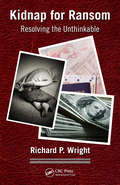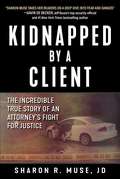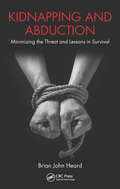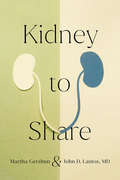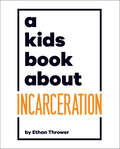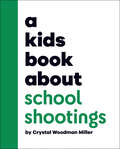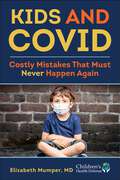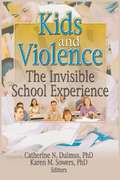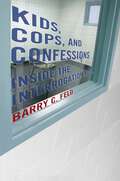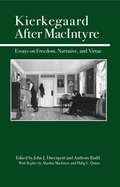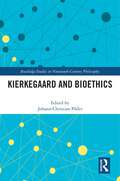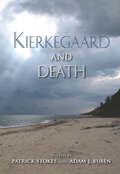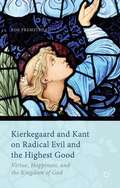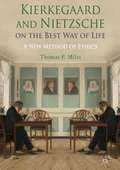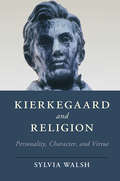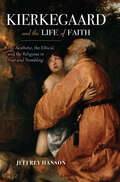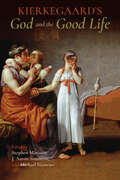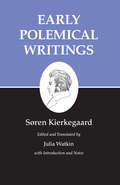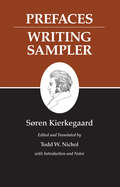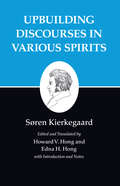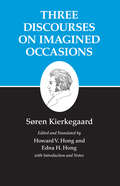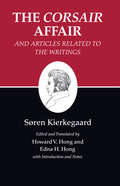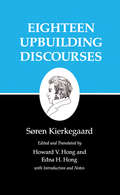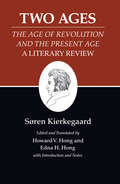- Table View
- List View
Kidnap for Ransom: Resolving the Unthinkable
by Richard P. WrightThe enormous sums paid for the release of hostages coupled with law enforcement‘s inability to stem the tide has made kidnapping for ransom a worldwide plague. The increasing rate of reported incidents from every corner of the globe suggests this plague is growing. Kidnap for Ransom: Resolving the Unthinkable removes the veil of mystery and dispels
Kidnapped by a Client: The Incredible True Story of an Attorney's Fight for Justice
by Sharon R. Muse&“He promised to kill me when he got out. I believed him. If I wanted justice, I had to fight both him and the courts...maybe kill him first. If I didn&’t do something, I was going to die.&” This is not a manufactured dialogue from a thriller but the words of attorney Sharon Muse. They came after she survived an attempted kidnapping, rape, and murder at the hands of Larry Morrison, a former client. On April 7, 2006, Muse miraculously escaped from the sociopathic Morrison, only to find that the threat to her life was just beginning. Ineptitude in the justice system threatened to release Morrison and allow him the opportunity to finish the job, which he adamantly pledged to do. Muse would have to fight at every step to ensure her safety. Muse would act as her own advocate, investigator, legal counsel, and bodyguard in the years following the event. Kidnapped by a Client covers the brutal kidnapping, two trials, two appeals, procedural errors galore, one Supreme Court reversal, and even Muse&’s intricate plan to murder Morrison before he could get to her. Muse would not ultimately execute that plan, and she would emerge victorious in the legal battle thanks to her faith and her own determination and legal acumen. But her safety is not ensured: Morrison is up for parole in 2026. Muse regularly monitors his status. Muse recounts her stranger-than-fiction story in Kidnapped by a Client. Muse analyzes the failures of the legal system, the mistakes she made, the steps she took to protect herself, and how she has coped with trauma. Readers will find not only a compelling narrative, but also insight into how to protect oneself and ensure one&’s own safety and well-being.
Kidnapping and Abduction: Minimizing the Threat and Lessons in Survival
by Brian John HeardTerrorist groups and organized crime cartels pose an increasing threat of kidnapping throughout many regions in the word. At the same time, international travel has become more commonplace for both business and leisure purposes. Kidnapping and Abduction: Minimizing the Threat and Lessons in Survival provides a practical guide on the precautions tra
Kidney to Share (The Culture and Politics of Health Care Work)
by Martha Gershun John D. LantosIn Kidney to Share, Martha Gershun tells the story of her decision to donate a kidney to a stranger. She takes readers through the complex process by which such donors are vetted to ensure that they are physically and psychologically fit to take the risk of a major operation. John D. Lantos, a physician and bioethicist, places Gershun's story in the larger context of the history of kidney transplantation and the ethical controversies that surround living donors. Together, they help readers understand the discoveries that made transplantation relatively safe and effective as well as the legal, ethical, and economic policies that make it feasible. Gershun and Lantos explore the steps involved in recovering and allocating organs. They analyze the differences that arise depending on whether the organ comes from a living donor or one who has died. They observe the expertise—and the shortcomings—of doctors, nurses, and other professionals and describe the burdens that we place on people who are willing to donate. In this raw and vivid book, Gershun and Lantos ask us to consider just how far society should go in using one person's healthy body parts in order to save another person.Kidney to Share provides an account of organ donation that is both personal and analytical. The combination of perspectives leads to a profound and compelling exploration of a largely opaque practice. Gershun and Lantos pull back the curtain to offer readers a more transparent view of the fascinating world of organ donation.
Kids Book About Incarceration, A (A Kids Book)
by Ethan ThrowerIncarceration is a BIG topic. Start the conversation early around the power of choices, consequences, justice, and growth.Incarceration is a big word for a HUGE topic. It can bring up difficult questions and feelings—especially when it affects you directly. This book explores incarceration, crimes, and prison, as well as the power of choices. The author's story highlights the impact of choices and how someone can grow, learn, and change the path they've been on.
Kids Book About School Shootings, A (A Kids Book)
by Crystal Woodman MillerThis book will help kids better understand what school shootings are and the emotions that come with the what if.School shootings have become an increasingly common and tragic reality. And while they're not as common as they feel, they are still very real, and so is the fear, anxiety, and trauma that comes with the awareness of them. This book will help grownups and kids start important conversations about school shootings and encourage everyone to be prepared for emergencies while reminding us that we should never let fear take over our lives.
Kids and COVID: Costly Mistakes That Must Never Happen Again
by Elizabeth MumperKids and COVID provides an in-depth look at mistakes pandemic officials made that hurt children and adolescents around the world. In spring of 2020, it was understandable that those directing government policies made errors of judgment since data was just emerging. However, within the first year of the declared pandemic, physicians and scientists from around the globe published data and made reliable observations that should have prompted a change of course. Dr. Elizabeth Mumper documents early warnings from eminent clinicians that repurposed drugs could be used to treat patients early, rather than waiting until they had trouble breathing, as advised. Sound epidemiological evidence suggested in March 2020 that the mortality rate of COVID was far less than was reported on mainstream news. Doctors in the trenches treating patients warned of the dangers of hospital protocols, including giving remdesivir with its high rate of kidney damage and omitting appropriate doses of short-term steroids. These scientists and clinicians were gaslighted and accused of spreading &“misinformation.&” The most vulnerable—the young and elderly—suffered massive psychological damage as their social networks were dismantled. Immune function changed as beneficial microbes were disrupted. You may be surprised that what you learn in this book is quite different from what you were told. Kids and COVID calls on parents to organize grassroots efforts on behalf of their children to make global shutdowns and prolonged school closures a &“one and done&” phenomenon.
Kids and Violence: The Invisible School Experience
by Catherine Dulmus Karen SowersImplement prevention interventions and policies to curb the cycle of violence in our schools!Kids and Violence: The Invisible School Experience examines overt and covert violence occurring in the school setting involving students, school personnel, and school policy, and highlights a level of violence that is often hidden, ignored, or subtly tolerated. This book provides the latest research findings on various issues of violence in our schools. It also shows what happens when the adults responsible for the well-being of our children are actually perpetrating violence, staying silent about violence, or upholding a system that supports a violent atmosphere.Kids and Violence is unique in its holistic and systemic approach of examining types of violence that are often overlooked or endorsed by school policies. The book includes 11 chapters focusing on issues such as bullying, school personnel&’s role in violence, and prevention programs. The contributors are experts in their fields and include professors, deans, and directors of university social work schools. Kids and Violence presents the results of an exploratory study that examines self-identified bullies and addresses issues of immediate and vital importance, including: bullying among students, grades 3-8, in a rural school district observations by school personnel on bullying among elementary and middle school students corporal punishment as a cultural norm in the United States and its impact on discipline in our schools solution-focused crisis intervention with adolescents bullying of children and other abuses of power by school personnel adolescent dating violence in the school setting and much more!It is time to stop the harmful cycle of violence in our schools. This valuable resource serves as a call for immediate action, showing social workers and policymakers how to provide leadership in researching, developing, and delivering empirically-based prevention interventions and policies.
Kids, Cops, and Confessions: Inside the Interrogation Room (Youth, Crime, and Justice #3)
by Barry FeldJuveniles possess less maturity, intelligence, andcompetence than adults, heightening their vulnerability in the justice system.For this reason, states try juveniles in separate courts and use differentsentencing standards than for adults. Yet, when police bring kids in forquestioning, they use the same interrogation tactics they use for adults,including trickery, deception, and lying to elicit confessions or to produceincriminating evidence against the defendants.In Kids, Cops, and Confessions, Barry Feld offers thefirst report of what actually happens when police question juveniles. Drawingon remarkable data, Feld analyzes interrogation tapes and transcripts, policereports, juvenile court filings and sentences, and probation and sentencingreports, describing in rich detail what actually happens in the interrogationroom. Contrasting routine interrogation and false confessions enables police,lawyers, and judges to identify interrogations that require enhanced scrutiny,to adopt policies to protect citizens, and to assure reliability and integrityof the justice system. Feld has produced an invaluable look at how the justicesystem really works.
Kierkegaard After MacIntyre
by Alasdair Macintyre Philip L. Quinn John J. Davenport Anthony RuddIn his extraordinarily influential book on ethics, After Virtue, Alasdair MacIntyre maintained that Kierkegaard's notion of "choosing" to interpret one's choices in ethical terms implies an arbitrary and irrational leap. MacIntyre's critique of Kierkegaard has become the focal point for several new interpretations of Kierkegaard that seek to answer MacIntyre. Kierkegaard After MacIntyre brings together both new and already published articles in this vein, with a new reply by Professor MacIntyre.Kierkegaard After MacIntyre reflects the emergence of a new consensus in Kierkegaard scholarship. This consensus is strongly anti-irrationalist and contemporary neo-Aristotelian virtue ethics, clarifying their common ground as well as their differences.In responding to MacIntyre's 'irrationalist' objection, the authors clarify the sense in which Kierkegaard's own conception of freedom is teleological and suggest that his understanding of the development of ethical personality involves a quest for narrative unity, a commitment to practices involving social values, and a self-understanding conditioned by historical reality-all of which are also central themes in MacIntyre's work on virtue ethics. Despite MacIntyre's diagnosis of Kierkegaard's existential approach to ethics as unsuccessful, some of Kierkegaard's insights may support MacIntyre's own theses."Kierkegaard After MacIntyre is an outstanding book which brings Kierkegaard into direct conversation with one of the most important contemporary philosophers. The conversation contains both lively disagreements and illuminating analyses, all focused on issues of fundamental importance for human life." -C. Stephen Evans, Calvin College". . . this wonderfully edifying collection of essays." -Timothy P. Jackson, Emory University"In addressing MacIntyre's charge that for Kierkegaard the adoption of the ethical can only be a 'cirterionless choice,' this stimulating set of essays by well-known Kierkegaard scholars provides a welcome addition to the literature on Kierkegaardian ethics. Kierkegaard After MacIntyre provides a valuable exploration of the role of reasoning, will, and passion in moral life, as well as of the relation between aesthetic and ethical dimensions of life." -M. Jamie Ferreira, University of Virginia
Kierkegaard and Bioethics (Routledge Studies in Nineteenth-Century Philosophy)
by Johann-Christian PõderThis book explores Kierkegaard’s significance for bioethics and discusses how Kierkegaard’s existential thinking can enrich and advance current bioethical debates. A bioethics inspired by Kierkegaard is not focused primarily on ethical codes, principles, or cases, but on the existential 'how' of our medical situation. Such a perspective focuses on the formative ethical experiences that an individual can have in relation to oneself and others when dealing with medical decisions, interventions, and information. The chapters in this volume explore questions like: What happens when medicine and bioethics meet Kierkegaard? How might Kierkegaard’s writings and thoughts contribute to contemporary issues in medicine? Do we need an existential turn in bioethics? They offer theoretical reflections on how Kierkegaard’s existential thinking might contribute to bioethics and apply Kierkegaardian concepts to debates on health and disease, predictive medicine and enhancement, mental illness and trauma, COVID-19, and gender identity. Kierkegaard and Bioethics will be of interest to scholars and advanced students working on Kierkegaard, bioethics, moral philosophy, existential ethics, religious ethics, and the medical humanities.
Kierkegaard and Bioethics (Routledge Studies in Nineteenth-Century Philosophy)
by Johann-Christian PõderThis book explores Kierkegaard’s significance for bioethics and discusses how Kierkegaard’s existential thinking can enrich and advance current bioethical debates.A bioethics inspired by Kierkegaard is not focused primarily on ethical codes, principles, or cases, but on the existential 'how' of our medical situation. Such a perspective focuses on the formative ethical experiences that an individual can have in relation to oneself and others when dealing with medical decisions, interventions, and information. The chapters in this volume explore questions like: What happens when medicine and bioethics meet Kierkegaard? How might Kierkegaard’s writings and thoughts contribute to contemporary issues in medicine? Do we need an existential turn in bioethics? They offer theoretical reflections on how Kierkegaard’s existential thinking might contribute to bioethics and apply Kierkegaardian concepts to debates on health and disease, predictive medicine and enhancement, mental illness and trauma, COVID-19, and gender identity.Kierkegaard and Bioethics will be of interest to scholars and advanced students working on Kierkegaard, bioethics, moral philosophy, existential ethics, religious ethics, and the medical humanities.
Kierkegaard and Death
by Patrick Stokes andssss Adam J. Buben“This impressive [anthology] succeeds admirably at demonstrating how the Kierkegaardian corpus presents . . . a philosophy of finite existence” (Notre Dame Philosophical Reviews).Few philosophers have devoted such sustained, almost obsessive attention to the topic of death as Søren Kierkegaard. Kierkegaard and Death brings together new work on Kierkegaard’s multifaceted discussions of death and provides a thorough guide to the development, in various texts and contexts, of Kierkegaard’s ideas concerning death.Essays by an international group of scholars take up essential topics such as dying to the world, living death, immortality, suicide, mortality and subjectivity, death and the meaning of life, remembrance of the dead, and the question of the afterlife. While bringing Kierkegaard’s philosophy of death into focus, this volume connects Kierkegaard with important debates in contemporary philosophy.
Kierkegaard and Kant on Radical Evil and the Highest Good
by Roe FremstedalKierkegaard and Kant on Radical Evil and the Highest Good is a major study of Kierkegaard's relation to Kant that gives a comprehensive account of radical evil and the highest good, two controversial doctrines with important consequences for ethics and religion. Fremstedal offers an original account of Kierkegaard and his role in the history of philosophy that reconstructs several of his central ideas by relating them to Kant and partially also to contemporary debates. By offering a comparative presentation, the book shows how Kant and Kierkegaard offer different accounts of evil and its complex relations to religious faith and happiness. Fremstedal sheds new light on Kierkegaard's argument against secular thinking, and shows that there are more Kantian elements in Kierkegaard than has been acknowledged. Kierkegaard's use of Kantian ideas is instructive, since it points to problems with Kant's philosophy of religion and indicates how Kantian philosophy can be used to defend religious faith and hope.
Kierkegaard and Nietzsche on the Best Way of Life
by Thomas P. MilesKierkegaard and Nietzsche revive an ancient approach to ethics that evaluates different ways of life considered as a whole. Comparing and contrasting their respective ideals of faith and individual sovereignty, this work reveals a valuable new path for contemporary ethics.
Kierkegaard and Religion: Personality, Character, And Virtue (Cambridge Studies In Religion, Philosophy And Society )
by Sylvia WalshNo thinker has reflected more deeply on the role of religion in human life than Søren Kierkegaard, who produced in little more than a decade an astonishing number of works devoted to an analysis of the kind of personality, character, and spiritual qualities needed to become an authentic human being or self. <p><p>Understanding religion to consist essentially as an inward, passionate, personal relation to God or the eternal, Kierkegaard depicts the art of living religiously as a self through the creation of a kaleidoscope of poetic figures who exemplify the constituents of selfhood or the lack thereof. The present study seeks to bring Kierkegaard into conversation with contemporary empirical psychology and virtue ethics, highlighting spiritual dimensions of human existence in his thought that are inaccessible to empirical measurement, as well as challenging on religious grounds the claim that he is a virtue ethicist in continuity with the classical and medieval virtue tradition.<p> Explores and clarifies the concepts of personality, character, and virtue in Kierkegaard's thought.<p> Elucidates the dialectic of jest and earnestness, human agency and divine agency, human striving and grace in Kierkegaard's thought.<p> Relates Kierkegaard's concepts of personality, character, and virtue to alternative approaches in contemporary philosophy, theology, and empirical psychology.
Kierkegaard and the Life of Faith: The Aesthetic, the Ethical, and the Religious in Fear and Trembling
by Jeffrey Hanson“A thorough, considered, and provocative treatment of what justifiably remains Kierkegaard’s most famous book.” —Marginalia Review of BooksSoren Kierkegaard’s masterful work Fear and Trembling interrogates the story of Abraham and Isaac, finding there one of the most profound and critical dilemmas in all of religious philosophy. While several commentaries and critical editions exist, Jeffrey Hanson offers a distinctive approach to this crucial text.Hanson gives equal weight to all three of Kierkegaard’s “problems,” dealing with Fear and Trembling as part of the entire corpus of Kierkegaard’s thought and putting all parts into relation with each other. Additionally, he offers a distinctive analysis of the Abraham story and other biblical texts, giving particular attention to questions of poetics, language, and philosophy, especially as each relates to the aesthetic, the ethical, and the religious.Presented in a thoughtful and fresh manner, Hanson’s claims are original and edifying. This new reading of Kierkegaard will stimulate fruitful dialogue on well-traveled philosophical ground.
Kierkegaard's God and the Good Life
by J. Aaron Simmons Michael Strawser Stephen MinisterKierkegaard's God and the Good Life focuses on faith and love, two central topics in Kierkegaard's writings, to grapple with complex questions at the intersection of religion and ethics. Here, leading scholars reflect on Kierkegaard's understanding of God, the religious life, and what it means to exist ethically. The contributors then shift to psychology, hope, knowledge, and the emotions as they offer critical and constructive readings for contemporary philosophical debates in the philosophy of religion, moral philosophy, and epistemology. Together, they show how Kierkegaard continues to be an important resource for understandings of religious existence, public discourse, social life, and how to live virtuously.
Kierkegaard's Writings, I
by Søren Kierkegaard Julia WatkinEarly Polemical Writings covers the young Kierkegaard's works from 1834 through 1838. His authorship begins, as it was destined to end, with polemic. Kierkegaard's first published article touches on the theme of women's emancipation, and the other articles from his student years deal with freedom of the press. Modern readers can see the seeds of Kierkegaard's future career these early pieces. In "From the Papers of One Still Living," his review of Hans Christian Andersen's novel Only a Fiddler, Kierkegaard rejects the notion that environment is decisive in determining the fate of genius. He also puts forward his belief that each person needs a life-view or life for which and by which to live, a thought he explores further in the comic play The Battle between the Old and the New Soap-Cellars.
Kierkegaard's Writings, IX
by Søren Kierkegaard Todd W. NicholPrefaces was the last of four books by Søren Kierkegaard to appear within two weeks in June 1844. Three Upbuilding Discourses and Philosophical Fragments were published first, followed by The Concept of Anxiety and its companion--published on the same day--the comically ironic Prefaces. Presented as a set of prefaces without a book to follow, this work is a satire on literary life in nineteenth-century Copenhagen, a lampoon of Danish Hegelianism, and a prefiguring of Kierkegaard's final collision with Danish Christendom. Shortly after publishing Prefaces, Kierkegaard began to prepare Writing Sampler as a sequel. Writing Sampler considers the same themes taken up in Prefaces but in yet a more ironical and satirical vein. Although Writing Sampler remained unpublished during his lifetime, it is presented here as Kierkegaard originally envisioned it, in the company of Prefaces.
Kierkegaard's Writings, X
by Howard V. Hong Edna H. Hong Søren KierkegaardThree Discourses on Imagined Occasions was the last of seven works signed by Kierkegaard and published simultaneously with an anonymously authored companion piece. Imagined Occasions both complements and stands in contrast to Kierkegaard's pseudonymously published Stages on Life's Way. The two volumes not only have a chronological relation but treat some of the same distinct themes. The first of the three discourses, "On the Occasion of a Confession," centers on stillness, wonder, and one's search for God--in contrast to the speechmaking on erotic love in "In Vino Veritas," part one of Stages. The second discourse, "On the Occasion of a Wedding," complements the second part of Stages, in which Judge William delivers a panegyric on marriage. The third discourse, "At a Graveside," sharpens the ethical and religious earnestness implicit in Stages's "'Guilty'/'Not Guilty'" and completes this collection.
Kierkegaard's Writings, X: Three Discourses on Imagined Occasions
by Howard V. Hong Edna H. Hong Søren KierkegaardThree Discourses on Imagined Occasions was the last of seven works signed by Kierkegaard and published simultaneously with an anonymously authored companion piece. Imagined Occasions both complements and stands in contrast to Kierkegaard's pseudonymously published Stages on Life's Way. The two volumes not only have a chronological relation but treat some of the same distinct themes. The first of the three discourses, "On the Occasion of a Confession," centers on stillness, wonder, and one's search for God--in contrast to the speechmaking on erotic love in "In Vino Veritas," part one of Stages. The second discourse, "On the Occasion of a Wedding," complements the second part of Stages, in which Judge William delivers a panegyric on marriage. The third discourse, "At a Graveside," sharpens the ethical and religious earnestness implicit in Stages's "'Guilty'/'Not Guilty'" and completes this collection.
Kierkegaard's Writings, XIII: The "Corsair Affair" and Articles Related to the Writings
by Howard V. Hong Edna H. Hong Søren KierkegaardThe Corsair affair has been called the "most renowned controversy in Danish literary history." At the center is Søren Kierkegaard, whose pseudonymous Stages on Life's Way occasioned a frivolous and dishonorable review by Peder Ludvig Møller. Møller was associated with The Corsair, a publication notorious for gossip and caricature. The editor was Meïr Goldschmidt, an acquaintance of Kierkegaard's and an admirer of his early work. Kierkegaard struck back at not only Møller and Goldschmidt but at the paper as a whole. The present volume contains all of the documents relevant to this dispute, plus a historical introduction that recapitulates the sequence of events surrounding the controversy. Parts I (Article) and II (Addenda) contain articles both signed by and attributed to Kierkegaard in response to the affair. A supplement includes writings pertaining to the Corsair affair by Goldschmidt and Møller, as well as unpublished pieces by Kierkegaard from his journals and papers. Although the immediate occasion was literary, for Kierkegaard the issues as well as the consequences were ethical, social, philosophical, and religious. Howard Hong argues that the most important consequence was wholly unexpected and unintended: the second phase of Kierkegaard's authorship.
Kierkegaard's Writings, XIV
by Howard V. Hong Edna H. Hong Søren KierkegaardAfter deciding to terminate his authorship with the pseudonymous Concluding Unscientific Postscript, Kierkegaard composed reviews as a means of writing without being an author. Two Ages, here presented in a definitive English text, is simultaneously a review and a book in its own right. In it, Kierkegaard comments on the anonymously published Danish novel Two Ages, which contrasts the mentality of the age of the French Revolution with that of the subsequent epoch of rationalism. Kierkegaard commends the author's shrewdness, and his critique builds on the novel's view of the two generations. With keen prophetic insight, Kierkegaard foresees the birth of an impersonal cultural wasteland, in which the individual will either be depersonalized or obliged to find an existence rooted in "equality before God and equality with all men." This edition, like all in the series, contains substantial supplementary material, including a historical introduction, entries from Kierkegaard's journals and papers, and the preface and conclusion of the original novel.
Kierkegaard's Writings, XIV: "The Age of Revolution" and the "Present Age" A Literary Review
by Howard V. Hong Edna H. Hong Søren KierkegaardAfter deciding to terminate his authorship with the pseudonymous Concluding Unscientific Postscript, Kierkegaard composed reviews as a means of writing without being an author. Two Ages, here presented in a definitive English text, is simultaneously a review and a book in its own right. In it, Kierkegaard comments on the anonymously published Danish novel Two Ages, which contrasts the mentality of the age of the French Revolution with that of the subsequent epoch of rationalism. Kierkegaard commends the author's shrewdness, and his critique builds on the novel's view of the two generations. With keen prophetic insight, Kierkegaard foresees the birth of an impersonal cultural wasteland, in which the individual will either be depersonalized or obliged to find an existence rooted in "equality before God and equality with all men." This edition, like all in the series, contains substantial supplementary material, including a historical introduction, entries from Kierkegaard's journals and papers, and the preface and conclusion of the original novel.
